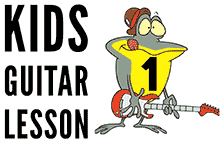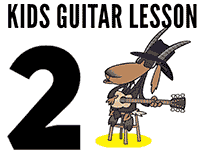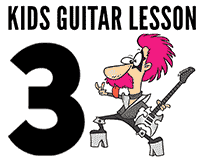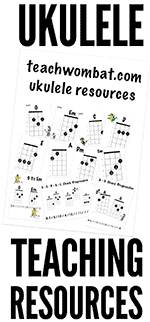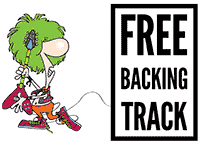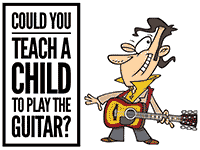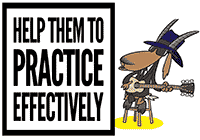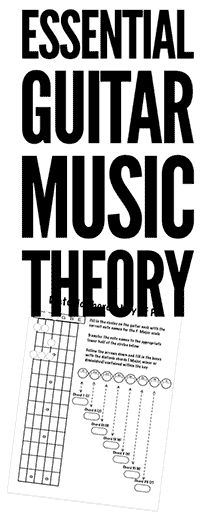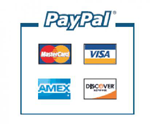
Ukulele has become a staple of the modern music classroom
From its historical origins in Portugal to worldwide acceptance the ukulele is fine musical instrument in its own right as well as being an effective "gateway drug" to the guitar for younger learners
Forming chord shapes and strumming rhythmically.Thats what all beginners (kids and adults alike) need to do on the guitar and thats also what they do on the ukulele
This material is designed for teachers who already use ukuleles as part of their teaching activities but could find a use for a bunch of well organised backing tracks and chord charts or for guitar teachers considering "dipping their toes" into the world of ukulele
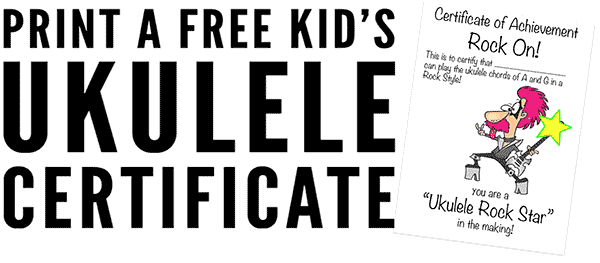
The certificate that you can download from the link above goes along with a beginner's ukuklele lesson that you will find covered in more delail later in this page'

Ten "ready to go" Backing Tracks for Ukulele Lessons
The resources feature chord charts for ten of the teachwombat resources originally devised for beginner guitar players which transfer straight across into being ideal for the novice uke strummer. They offer a great way to have students develop a good sense of timing right from the start

A First Ukulele Lesson
Just as is the case with guitar in the early stages all students need to concern themselves with is to form chord shapes and having done that they need to practice changing between them in time to music
It is perfectly possible to just follow the plans for the early stages of playing guitar as the aims are the same whichever instrument is being played and progress can be assured by playing along with the backing track. The track itself is two bard of each chord repeated "round and round" for a couple of minutes or so providing the opportunity for concentrated practice. Another advantage of using this method is that when teaching groups of students all of them can busy (and improve) themselves by playing along with the track while the teacher can spend some time with individual learners helping them to iron out problems etc
Click below to hear a section of the backing track designed to be used during a first ukulele lesson where learners are working on moving between the chords of G and Em in time to a band

A second ukulele lesson
When the first two chords have been learned and students are ok (remember at this stage it does not have to sound perfect) at moving between them it is time to introduce two more important chords
C and D are the last two chords of "The Four Chord Trick" in the key of G to be discussed at more length later. You can see the handouts above and hear a snippet of the backing track below

Combining all of the chords in a single progression
This backing track uses all of the chord shapes learned so far into a single progression and again features each shape for two bars at a moderate tempo which leaves plenty of time to change between the shapes which is vital during the early stages of playing
The chord chart that accompanies this backing track (and all of the others for that matter) is presented in two versions. Firstly as you can see above where cartoon characters are used to make them more appealing to younger students and there ia also an alternative "cartoon free" version for older learners
How To teach Children Ukulele

The "Four Chord Trick" for Ukulele
When your students can move comfortably between the four chords covered to this point then they can "do" the "four chord trick" in the key of G. What this really means is that they are able to work with the most "important" chords in the key of G (the ones used in literally thousands of popular songs) and the world starts to open up for them. Although I sell backing tracks and they are a great (the best!) way to get people from the beginner to the intermediate stage of playing they are a means to an end. While students are delighted to be able to play along with the tracks where they know they are really heading is to the point that they can play the songs that they know and love. There are tens of thousands of songs that use only the chords in the "Four Chord Trick"
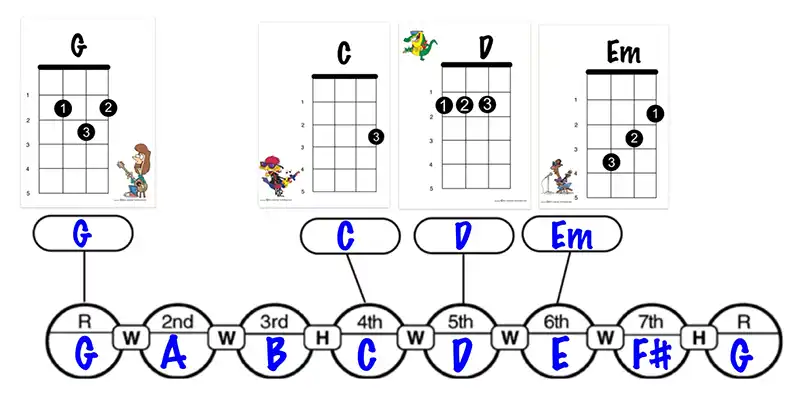
How does "The Four Chord Trick" work?
Take the notes of a G Major Scale G A B C D E and F sharp and number them one through to seven (G= one, A= two etc)
The chords built on the first (G), fourth (C), and fifth (D) notes have a "Major" chord quality while the chord that can be built using the sixth note (E) as the root is assigned a "minor" chord quality meaning that it is an Em chord
G, C, D and Em. The "Four Chord Trick" in the key of G
If you follow the link below you will find a more detailed version of why the four chord trick works in any key (not just G) and also be able to take a look at some resources that will help get the theory over to students who are leaving the beginner stage and entering into the "intermediate" stage of playing where it is useful to know what you are doing rather than just where to press your fingers down to make a nice noise

Reinforcing Knowledge and Capability on The Ukulele
Its not just about learning new chords. Having learned the four chord shapes it is important that our students develop the ability to move between them at will. They need to know how to form and move between all of the chords and not just to follow a single sequence.
There are two more backing tracks that go along with the two chord sheets presented above that feature the chords combined into another pair of commonly encountered sequences. If you look at the sheets (in the graphic above) you will notice that each chord lasts for a single bar rather than the two bars of each featured in the backing tracks up to this point. While the tracks are still presented at a moderate tempo they are designed to help students to become familiar with the idea of changing between the chord shapes more quickly

Kids Love These Certificates of Achievement!
I originally put together a bunch of these for my children's guitar lessons and although I expected them to work I was stunned at how well they went down. I shouldn't have been because after all everybody likes to feel recognised for their achievements. From "employee of the month" awards posted on notice boards and websites to "World's Best Grandma" on a cup you can buy from Walmart its just nice to know that other folks have recognised how well we are doing.
Another advantage of these things though is that the little darlings can't wait to take them home to the parents (who pay us) and insist that they are stuck up on a bedroom wall or fridge reminding those who control the purse strings that we are there and worthy of next term's enrolment fee. I dont like to appear so mercenary but I think of the certificates as being about recognising effort and also as advertising materials for my business

The certificate that you can download from the link above goes along with the lesson detailed below

Teaching Rock Ukulele!
"Teaching Rock Ukulele" is not a phrase I ever thought I'd type but life turns out to be full of surprises. When I use this backing track with he handout that goes with it in my children's guitar lessons the main problem that I have is to get them to agree to play anything else!
Two bars of A followed by another two of G and an aggressive "Rock" bass and drum backing track. Its great for working on ever more complicated "down-up" strumming patterns and they love doing the "Rock Ending" after the vocalist featured on the track (doing his best Brian Johnson impersonation) leads strummers to a final huge A chord. I ask kids to pull "Rock Star Faces" and (sitting down) poses at the end of this one and they love it. I guess I do too.
Use the audio player below to hear a sample of the track
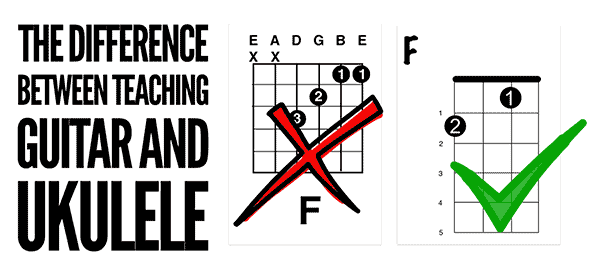
The difference between teaching guitar and ukulele
Up until this point the ukulele resources are simply a direct adaptation of the guitar resources. We have looked at five of the eight chords that are used by guitar teachers all over the world to get their beginner students off to a flying start
If I continued straight on to the next three chords (Am, Dm and E) then that would be ok but the truth is that the E chord is not so easy to form for a beginner as some other "useful" chord shapes that present themselves on the ukulele so we will take a little "detour" into some of the possibilities thrown up by the instrument
The ukulele (unlike the guitar) is great for using with beginners in the key of C

If we look back at the "four chord trick" covered (in the key of G, beloved of guitar teachers because the chord shapes that sound good together are the easiest for beginners to form) near the top of this page we can see that it is concerned with the identification of the "important" chords within a particular key and that we identified the chords based on the first, the fourth , the fifth and the sixth degrees of any Major Scale as being the root notes of the "important" (meaning they sound good when put together in chord sequences) chords
The problem is that even though the key of C major is a great place to start when trying to study or pass on a knowledge of music theory it is an awful key to introduce to a beginner on the guitar
Guitar teachers (or the good ones anyway) do not introduce beginners to the key of C in the early stages because quite simply one of the "important" chords in the key (F) is just way too difficult for a novice to play. It requires that the learner (who is slowly getting used to the physical process of pressing a single string onto the fingerboard) to suddenly have to hold down two strings with a one finger
When I look back at my first attempt to learn the guitar I bought a book that attempted to teach me in the (easiest to understand theoretically) key of C. I genuinely became discouraged very quickly and swapped the guitar for a fishing rod and I didn't come back to playing for a couple of years
The "Four Chord Trick" in the Key of C
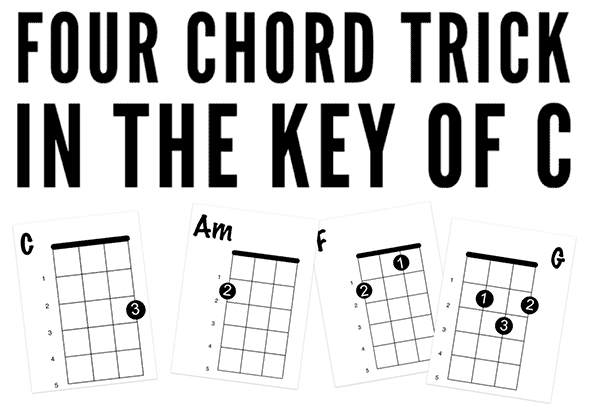
The good news is that the F chord is easy to play on the ukulele and we already know the three other chords
That means that just by leaning the F shape our students can operate very effectively in two of the most important keys
This page is a "work in progress and will be added to in he course of the next few days: Thanks for reading this far!

Eight of the most useful beginners ukulele chords presented as giant "mini posters" (if thats not a contradiction in terms?) that you can print and display on your teaching studio walls or give to your students so that they can do the same. The posters can also be laminated and used during group sessions.
The download features two versions of each giant ukulele chord and Chord Chart
I have produced two versions of each chord with cartoon characters included on the ones for younger students with regular (no cartoon) versions for older students who may feel that they are too "grown up" for such things. I personally like the cartoon ones but maybe that says more about me than the ukulele playing population at large
The Deluxe Package:
Download absolutely everything you see on this website for just $25.00
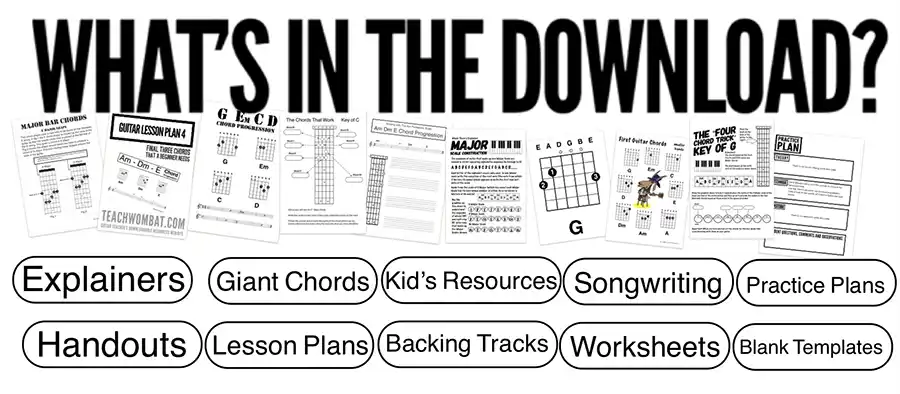
Whats in the download?........
The Guitar Teacher's Toolkit
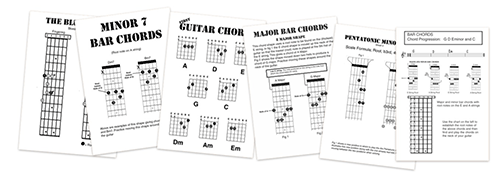
100 printable sheets dealing with Open Chords-Bar Chords-Scales- Modes- Blank Fretboard and Chord Grids Teaching Diary and Business Card Designs
The Backing Tracks and Handouts Package

35 backing tracks and over 80 chord sheets and handouts to go with them An invaluable aid designed to help you to teach both rhythm and lead guitar to younger and older students alike Great for helping to develop a good sense of timing (which will last a lifetime) in a novice player
The Kids Guitar Teaching Package

More than forty sheets designed to help you to Teach Guitar to Children This material is designed to run alongside the "Backing Tracks and Handouts Package . All of the material that you need in order to teach kids to play guitar. Chord Charts, One finger (reduced) chord diagrams. An opportunity to start any young would be guitar player off the right way!
Plus 100 Giant (letter sized) Chord Grids

laminate them in order to help you to teach group guitar lessons, distribute them to your students or just stick on your teaching studio wall? The "Coolest Wallpaper on the planet?"
And a freebie from us to you!
The Bass Guitar Teacher's Toolkit

Over 60 Handouts for anyone who already teaches (or who wishes to teach) bass guitar covering Scales, Chords, Fingering Exercises etc
Over 400 Sheets and 35 Backing tracks to Download and use TODAY!
Everything you need to start or improve a guitar teaching business! It's all there!
Only $25.00
HOW TO DOWNLOAD
the teachwombat materials
Buy your teachwombat.com toolkits in complete safety via any major credit card (through paypal) or directly through your paypal account if you have one. If you choose to use a credit card, rest assured that we never see your credit card details as paypal do all of that for us.
When Paypal receive your payment you will be immediately invited to click a
"RETURN TO MERCHANT"button.
You will be taken to a page from where you can download the products that you have paid for NOW!
In the (rare) event that something should go wrong with the order/download process just email me at robh@teachwombat.com
I will check the order and send you the links that will get you to your stuff.
Cheers! Rob!
They take care of the payment side and you can be sure that we never get to see your credit card details
Click The PayPal logo above to purchase and download the guitar teacher's toolkits NOW

